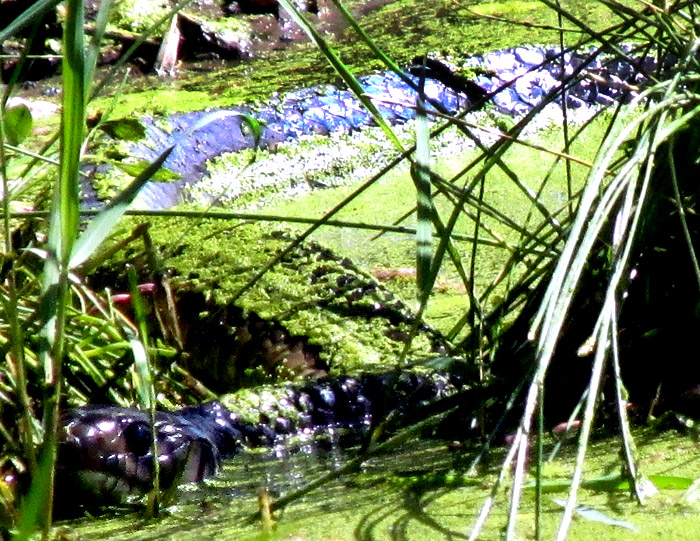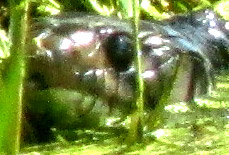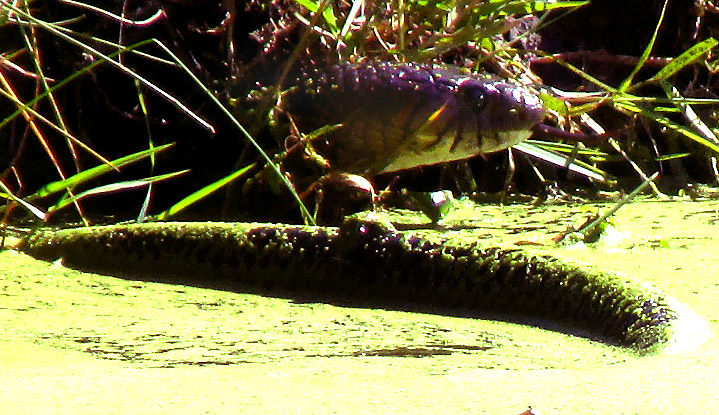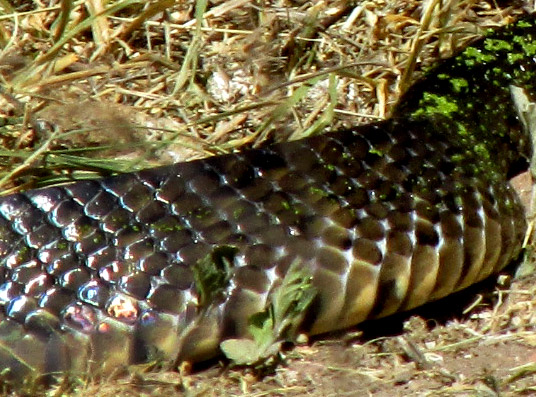Excerpts from Jim Conrad's
Naturalist Newsletter
Entry dated June 24, 2023, issued from near Tequisquiapan, elevation about 1,900m (6200 ft), Querétaro state, MÉXICO
(~N20.57°, ~W99.89°)
BLACKBELLY GARTER SNAKE

Thanks to a big landowner who, from inattention, lets his irrigation pumps run long after his fields are saturated, a certain little pond usually stays full of water, even when all others have gone dry. Though the waste of groundwater is inexcusable, wildlife in the pond's area benefits, like the above watersnake.
At 9:30AM the snake crossed a house-size sunny, scrubby expanse, possibly having visited a dried-up pond a stone's throw away. This was surprising, because the black snake was strikingly visible in the short, overgrazed, drought-killed grass, and a White-tailed Kite and a Red-tailed Hawk patrol this area constantly, both known to prey on snakes.
In the above picture, notice how two rows of scales on the snake's back form a kind of flat zone running atop the spine, collecting tiny Brazilian Watermeal plants, which must provide decent camouflage. The photo was taken at a distance, with the snake approaching. I anticipated a great shot of the head scales for identification purposes,  but then the camera's battery died, the dog saw the snake, freaked out, and the snake retraced his route. At the right, the head is shown larger and overexposed, to highlight the head scales.
but then the camera's battery died, the dog saw the snake, freaked out, and the snake retraced his route. At the right, the head is shown larger and overexposed, to highlight the head scales.

Above, the snake has returned to the far bank and looks around before leaving the pond. On the pond's far side, as the snake escaped across the parched grass, a picture was possible of the body mid-section, though the snake's head already had disappeared into a tangle of grass and scrub. Hare's the picture:

The slender, black lines radiating outward and downward from the snake's eye, and continuing below the mouth, reminded me of the Broad-banded Watersnakes back in Mississippi. That species was a member of the colubrid subfamily Natricinae, so in the 2023 study by Mauricio Tepos-Ramírez and others entitled "Annotated checklist of amphibians and reptiles from Querétaro, Mexico, including new records, and comments on controversial species," a look was taken at species in that family occurring in Querétaro.
After comparing Internet pictures of Querétaro species in that subfamily, the possibilities came down to two species: the commonly occurring Thamnophis eques, and Thamnophis melanogaster, on the IUCN Red List listed as endangered. Both of these species occur in this area, and both manifest several subspecies and color forms. By paying close attention to head scale arrangement, our pond snake was determined to be the endangered THAMNOPHIS MELANOGASTER.
In North America, various garter snake species belong to the genus Thamnophis, which must explain why the English name for our Thamnophis melanogaster is Blackbelly Garter Snake, instead of being thought of as a watersnake. In Spanish it's considered the culebra de agua de panza negra, or "black-bellied watersnake." While most pictures I find of the species don't show snakes with black bellies, sometimes the bellies are indeed black. You just can't trust common names.
Our snake must have been very hungry to have exposed himself as he did, but with the drought and all the dried-up ponds and reservoirs he may have had no choice. And when you consider all the wetlands which have been destroyed or at least polluted in the central Mexican uplands to which the species is endemic, it's understandable why the species is listed as endangered.